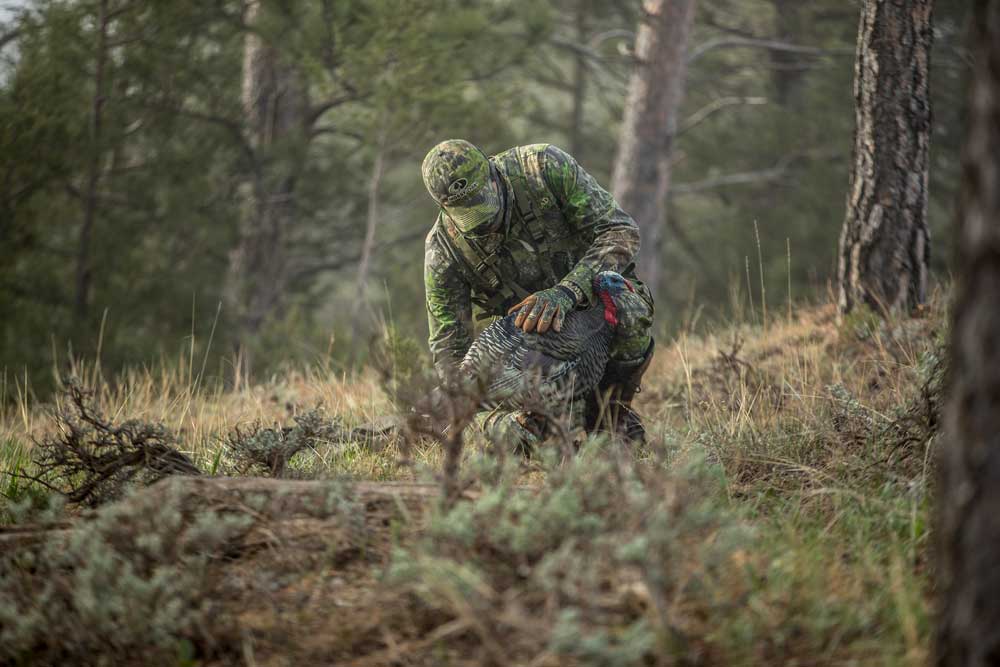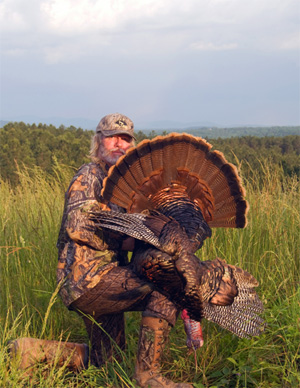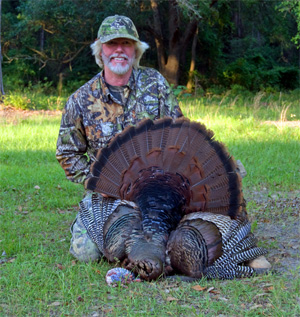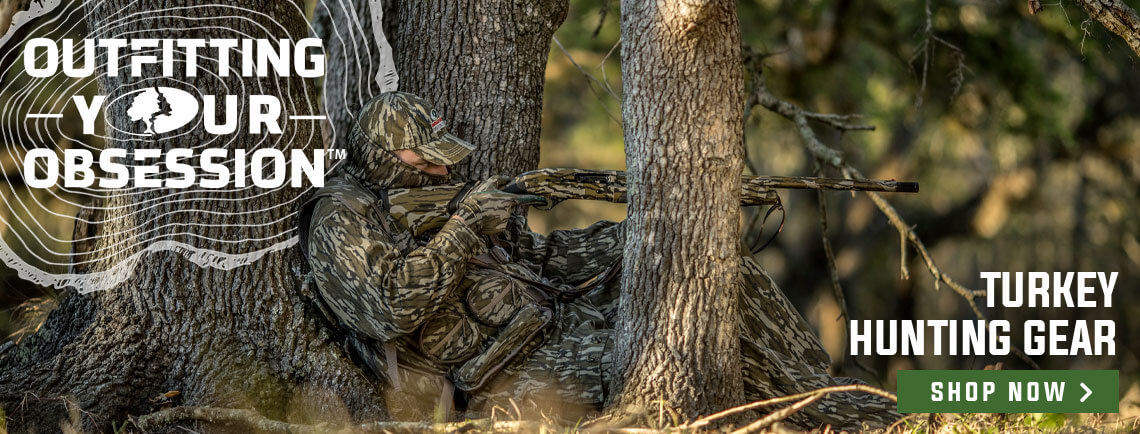By Bobby Parks

I believe it’s safe to say that most turkey hunters live for the morning hunt. The gobbling at the break of day removes any question marks as to whether a gobbler is around. Excitement, enthusiasm and adrenaline are at peak readings. The decision making process begins and an approach is applied to a given situation. This usually involves the typical form of closing in on a tom, setting up calling and pointing your gun in the direction of the gobbling. You have an idea of where to be, where the bird is and that it’s time to work the bird. Aggressive tactics, such as trolling and covering lots of ground trying to strike a tom, often yield a positive outcome and put you in a similar setup situation. The fact that birds gobble and their location is known takes some of the guesswork out of it. Again, mornings generally provide faster and hotter action with vocal birds, making it the preferred time to turkey hunt.
The problem with mornings is they fade away and turn into afternoon and afternoons don’t always provide the same scenarios. In fact, gobbling, the success of aggressive tactics and even our energy levels fade with it. The pace of the activity dial turns down a few hours after they leave the roost and then tweaks back up later in the day. Without sound tactics, you can spend the afternoon looking at your decoys and texting your buddies at the diner.

I started turkey hunting afternoons 20 years ago — not because I wanted to, but because I was two hours away from home hunting on the Flint River. I had nothing else to do once the morning hunt was over. The others who hunted our lease at that time were out of the woods by midmorning at the latest, but I decided it was better to spend the afternoon in the woods even if I were napping. At least there was a chance of killing a tom. I did not know how to go about it but I learned. What I soon realized was that I averaged an afternoon bird almost every year and, in some cases, would not have gotten a limit without that effort.
Afternoons in the Turkey Woods Can Be Productive
Birds can be taken at any time of the day as long as you’re in the field and vary your approaches. Self-discipline and a larger dose of patience comes into play. Just what the approach entails depends on the time of day, terrain features, hunting pressure and, to an extent, what part of the country you’re in. This is always on my mind as I hunt different parts of the country.
For example, out West in Montana, we may stay on the move most of the day looking for Merriams. In Texas, when hunting Rios, it’s more of a blended style of hunting involving trolling and staying with a setup for longer periods of time along with sequential calling. It’s the same in New Mexico, partly because it’s physically demanding but also because staying with a setup in the right location can be very productive, especially late in the day.

Generally speaking, afternoon hunting tactics for Easterns require a more passive and patient mindset, especially during the mid afternoon. For me, it has required a toned-down approach and picking good setup locations based on scouting and knowledge of the property. It’s much more difficult to simply drive around blind calling an Eastern. Even if you do locate a tom, he is so cautious that if there is any mistake, he is gone for the afternoon.
Mid Afternoon Trolling for Turkeys
No two turkey hunters are the same and many prefer to stay aggressive. The slower-paced “sit and wait” style of hunting doesn’t work for everyone. I’ll respect anyone’s approach, but I’m willing to do whatever it takes on any given day when it comes to putting a turkey on the ground, as long as it’s rewarding and works for me personally. My program is to always adjust to the conditions at hand and plan an approach based on conclusions drawn on a particular day. If birds are vocal, I’ll stay more aggressive. If they appear to have gone quiet, I turn the dial down.
I have not had a lot of luck moving and calling during the middle of the day when hunting in the Southeast. As a result, I slow down and move less. In fact, I’ve concluded that I do more damage and probably bump birds that I‘m not even aware of when doing this. I believe you can easily contribute to the “pressure factor” if you don’t recognize that a particular style of aggressive hunting is not working at certain times or on a given day. You can wear a good property out in a hurry if you don’t at least make an effort to put thought in the pressure you’re applying. The last thing you want is to push a tom to neighboring property.
If I do troll, it’s more of a slow-motion advance. I will move from location to location, stopping for short periods of time and cutting as hard and loud as I can to try and shock toms into gobbling. I may cut on a glass call, wait a couple of minutes and then do the same thing on a box call. I will use a crow call at times, as well as pay attention to real crows if they appear to be harassing something. I’ll then continue moving forward. I may spend 15-30 minutes in an area that I have reason to feel good about before continuing. This assumes you have a large enough tract to keep moving on. Smaller tracts may require that you set up for a long, motionless afternoon.
Scouting for Afternoon Turkeys
Having the right setup in my view is as important as good calling and is one of the keys to bringing a gobbler into range any time of day. Knowing the right ground to commit time to and what bird habits are on afternoon hunts are crucial for many reasons. First of all, you’ve got to be confident in a spot to have the patience to hang with it. Also, the gobbler is less likely to gobble and announce his location during an afternoon hunt, so being in the right location with proper concealment and minimal movement is a must. It comes down to previous scouting, bird encounters and your ability to read the signs and land you’re on. Even how you approach the location comes into play.
When I set up on morning hunts or on gobbling birds in the woods, I may set up in thicker terrain or just over a rise with the idea of making the gobbler have reason to keep looking for me. I’ll rarely set up in wide open places because my experience is that a gobbler that can see a long ways will just stand and gobble and not come in. Many so-called hang ups are due to bad setups. I compromise visibility distance because I have an idea of which way the gobbler will come from and my gun’s pointed in the right direction.
On afternoon hunts, especially if I’m in the woods and not a field, I’ll try to find a happy medium. I want to see farther because I’m expecting the bird to come in quiet and show up unannounced. I still want him to have reason to come looking but I want to have a better view as well. With a little effort, I can normally find a place to set up that lets me see, but doesn’t silhouette me against the horizon.
Logging roads that have turkey signs such as drag marks, dusting bowls, droppings or tracks all add up to define a potential kill zone.
I’ll try and find the right tree, shade and pile up anything that will help me blend in and hide movement. Trimming and stacking limbs, piling logs and sometimes pulling a piece of camo netting I carry in my vest works well. When I hunted in the river swamp, palmettos were great to cut and stick in the ground around me. I brush in my back sides so if he shows up behind me, I’m not busted before I have a clue he’s around. If you can do this prior to your hunt, all the better. Psyching out butt pain from sitting so you don’t move is important. I wear a vest because it offers padding both underneath and behind me which allows me to sit motionless for longer periods at a time. It seems every ill-timed move is rewarded with the cluck of a hen that scatters turkey everywhere.
No doubt, hearing wild turkeys fly down from their roost, hearing the morning’s first gobble and matching wits with a battle-weary old tom in full strut is as good as it gets. There is truth in the saying, “If you can roost them, you can roast them.” Unfortunately, many of us have roosted them and, at the end of the day, had nothing to roast. You can turn a busted morning hunt into a hot breakfast, or you can spend the afternoon turkey hunting. The afternoon turkey hunting tactics I have mentioned prove that it is possible to take an afternoon tom home to roast.
Part 2: Afternoon Hunting Tactics covers field hunting, calling sequences, late afternoons and varied approaches.





























